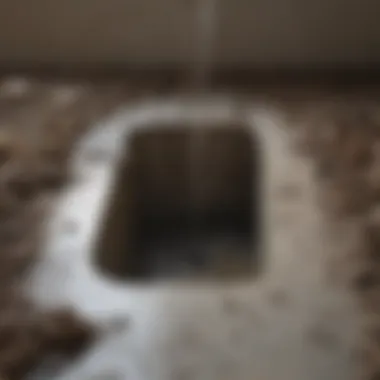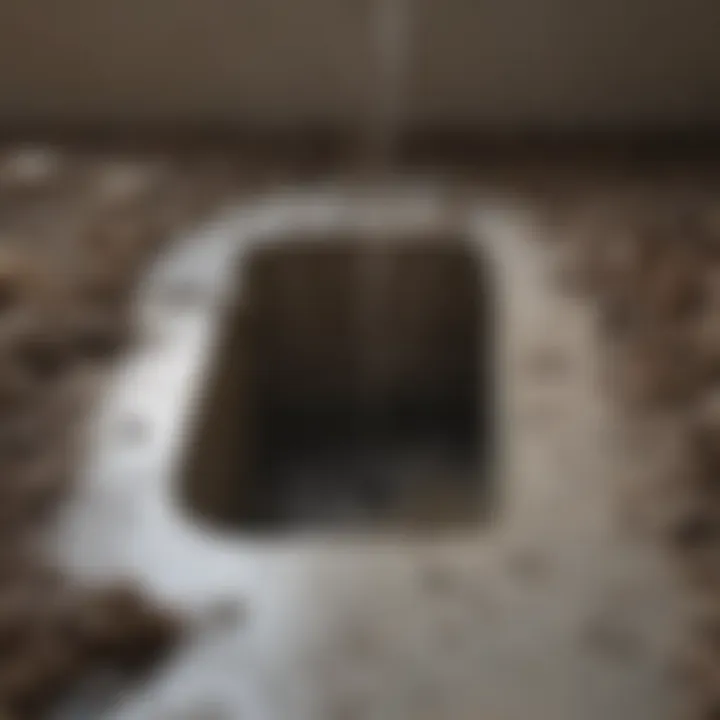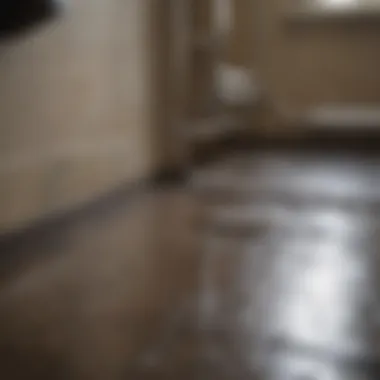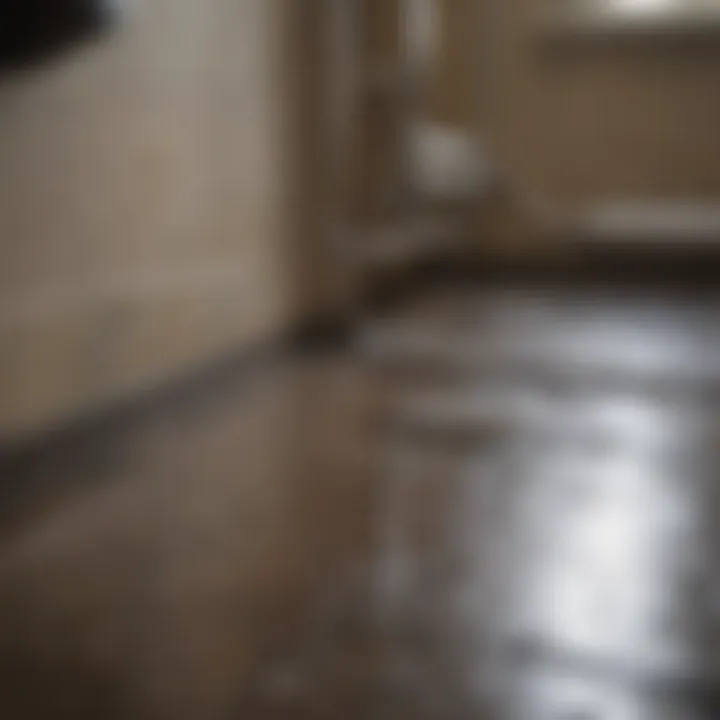Mastering Drain Clogs: Unclogging with a Wire Hanger


Intro
Clogged drains are a common issue faced by many homeowners. These blockages can cause inconvenience and sometimes lead to more serious plumbing problems. Often, the thought of hiring a plumber can be overwhelming, not just for the cost but also for the time it may take. A simple yet effective method that often goes overlooked is utilizing a basic wire hanger. This article will guide readers on how to effectively use a wire hanger to unclog drains, providing insights and practical strategies for those looking to solve plumbing issues without professional assistance.
By employing this common household item, individuals can save both time and money. Understanding the cause and type of clogs, along with safety precautions, is crucial to tackling plumbing challenges efficiently.
Materials Needed
Before diving into the unclogging process, it's essential to gather the proper materials. For using a wire hanger, one only requires:
- A wire hanger (preferably not plastic)
- A pair of pliers (optional, for bending)
- Gloves (to keep hands clean)
- A bucket or bowl (to catch debris)
These items will facilitate a straightforward and effective approach to unclogging drains. The wire hanger can be modified easily to reach various types of blockages without needing additional complex tools.
Step-by-Step Instructions
- Prepare the Wire Hanger: Start by straightening the hanger. Use pliers, if necessary, to ensure it is as smooth as possible. Leave a small hook at one end to catch debris.
- Protect Your Hands: Put on gloves to protect yourself from potential bacteria and debris.
- Locate the Clog: Insert the hooked end of the wire hanger into the drain. Gently push it through the drain to locate the clog.
- Extract the Debris: Once you reach the blockage, try to hook onto it and pull out as much debris as you can. This may take several attempts. Keep a bucket nearby to collect the debris.
- Flush the Drain: Once the debris is extracted, pour hot water down the drain to help clear any remaining residue.
Safety Precautions
While this method is relatively safe, a few precautions should be taken:
- Avoid using excessive force with the hanger. Doing so may damage the pipes.
- Ensure the area around the drain is dry to prevent slips.
- If the clog still persists after multiple attempts, consider seeking help from a professional plumber.
Common Types of Drain Clogs
Understanding the types of clogs one may encounter can also be beneficial:
- Hair and Soap Scum: Common in bathroom drains, these tend to accumulate, leading to clogs.
- Food Waste: Kitchen sinks can clog due to leftover food particles and grease buildup.
- Foreign Objects: Sometimes, small items can accidentally slip down and cause blockages.
Using a wire hanger is particularly effective for hair and soap scum. Its flexibility allows it to reach into narrow pipe openings.
Alternative Unclogging Methods
While a wire hanger is useful, there are other methods to consider:
- Plunger: A traditional plunger can often dislodge tougher clogs.
- Baking Soda and Vinegar: This natural solution can break down many organic clogs effectively.
- Drain Snake: For more persistent clogs, a mechanical snake may provide deeper access.
Preventative Measures
To minimize future clogs, consider these preventative strategies:
- Regular Cleaning: Clean drains regularly to remove buildup before it becomes a problem.
- Use Drain Covers: They can catch debris before it enters the pipes.
- Mind What You Flush: Only flush human waste and toilet paper to avoid unexpected clogs.
End
Utilizing a wire hanger is a practical and often overlooked approach to unclogging drains. This method is not only cost-effective but also demonstrates the value of resourcefulness in home maintenance. With a simple wire hanger, gloves, and a little patience, many plumbing issues can be resolved by homeowners themselves, preserving both time and finances. By following the steps outlined in this guide, maintaining clear drains can become a straightforward task.
Preface to Drain Clogs
Understanding the nature of drain clogs is essential for effective home maintenance. Drain blockages can lead to a myriad of inconveniences, whether slow drainage or complete stoppage. Such issues may escalate if ignored, leading to more extensive plumbing repairs. The topic of drain clogs appears simple, yet the implications of neglect can have significant effects on daily life. This section aims to familiarize homeowners with the fundamentals of drain blockages and why regular attention to this matter is beneficial.
Understanding Drain Blockages
Drain blockages occur when the flow of water is obstructed in pipes, causing backups or slow drains. Such blockages can originate from various sources, including food particles, hair, soap scum, and other debris. Awareness of what constitutes a blockage is crucial. In many cases, accumulated waste leads to a narrowed passageway, making it difficult for water to pass through efficiently.
The symptoms of a clogged drain are often evident. One may notice water pooling in sinks or bathtubs. In extreme cases, foul odors become apparent, indicative of stagnant water. Learning to recognize these signs helps in timely intervention, potentially saving time and cost associated with professional plumbing services.


Common Causes of Clogs
Several factors contribute to drain clogs, and understanding these can aid in prevention. Common causes include:
- Hair: One of the most prevalent culprits, especially in bathrooms. Hair can tangle and form sizable clumps, trapping other debris.
- Food Waste: In the kitchen, larger food particles can accumulate in the drain over time, leading to blockages, particularly if a garbage disposal is not used properly.
- Grease: Cooking grease can solidify in pipes, creating a sticky buildup that attracts other waste.
- Soap Deposits: Some soaps contain fats and oils that can solidify and contribute to obstructions.
Maintenance routines, including regular cleaning of drains and being conscious about what goes down them, can significantly reduce the likelihood of clogs. The importance of understanding these common causes cannot be overstated; it empowers homeowners to take proactive measures.
In summary, recognizing the causes and symptoms of drain clogs is the first step towards water flow restoration. This knowledge sets the foundation for more practical solutions, like using tools such as a wire hanger.
The Wire Hanger as a Tool
Using a wire hanger for unclogging drains is a practical solution that draws from common household items yet yields effective results. The utility of a wire hanger extends beyond its initial purpose of holding clothes. Repurposing it in plumbing maintenance not only saves costs but also empowers homeowners to tackle minor issues themselves. Understanding how a wire hanger can function as a tool is essential for anyone looking to improve their DIY skills and handle drain blockages without immediately resorting to professional help.
This approach offers multiple benefits. First, it is accessible; wire hangers are often found in most homes. This means that the resources needed to confront minor plumbing problems are readily available. Second, it requires minimal preparation and allows for quick action. As many individuals face delays from waiting for a plumber, using a wire hanger can provide immediate relief from a frustrating drain clog, demonstrating the practicality of this method.
Considerations that come into play include the need to understand the type of clog you are addressing. While a wire hanger is effective for specific types of blockages, like hair and small debris, other situations may require additional methods or tools. Utilizing a wire hanger thus serves as a valuable first step in unclogging drains, making it an essential topic in this guide.
Why Use a Wire Hanger?
Using a wire hanger as a tool for drain unclogging is based on both simplicity and efficiency. One key reason for its use is cost-effectiveness. Unlike specialized plumbing tools, wire hangers are inexpensive and often available at home. This practicality empowers homeowners to attempt a DIY fix before seeking more complicated solutions.
Another advantage is versatility. A wire hanger can be manipulated in various ways to reach and dislodge clogs in different types of drains, including sinks and bathtubs. With a little creativity, one can shape the hanger to suit specific drain configurations, enhancing its effectiveness.
Additionally, employing a wire hanger minimizes risk to the plumbing system. Unlike caustic chemical drain cleaners, which can cause damage if used incorrectly, a wire hanger is relatively safe. When used with care, it poses little threat to pipes, making it a favorable option for initial attempts at unclogging. The value of using a simple tool like a wire hanger lies in its ability to provide a quick and effective means to address minor plumbing issues without incurring significant costs or risks.
Types of Wire Hangers
Wire hangers come in different variations, each with unique features that can influence their effectiveness as tools for unclogging drains. The most common types include:
- Standard Wire Hangers: These are often flexible and easy to manipulate. Their thin profile can fit into tight spaces, making them ideal for reaching clogs in narrow pipes.
- Twisted Wire Hangers: These hangers provide additional rigidity due to their twisted design. This can aid in thrusting forcefully against stubborn clogs, allowing for a more aggressive approach when necessary.
- Plastic Coated Hangers: Although they are less common for this purpose, the plastic coating offers a better grip and may help prevent scratching or damaging the insides of pipes.
By selecting the right type of wire hanger, users can customize their approach to unclogging drains, ensuring they use the tool most suitable for the specific situation at hand. Each type has its own merits and can be assessed based on the clog's characteristics, such as depth and material obstructing the drain.
Preparation for Unclogging
Preparation is crucial when attempting to unclog drains using a wire hanger. A methodical approach ensures efficiency, safety, and effectiveness. This section focuses on two main elements: gathering necessary materials and assessing the clog location. Together, these steps form the foundation of a successful unclogging process.
Gathering Necessary Materials
Before starting, it is essential to gather all necessary materials. This not only streamlines the process but also minimizes interruptions. The most critical tool is, of course, the wire hanger. You will also need gloves to protect your hands from grime and potential sharp objects found in the drain. In some cases, a flashlight can help illuminate the area while you work.
Other materials can include:
- A bucket to collect debris and excess water
- Plumber's tape in case you need to seal any connections
- A cleaning rag or paper towels to tidy up afterwards
By ensuring you have everything on hand, you can avoid leaving the job halfway through for something you forgot. This preparation increases the chances of a successful unclogging on your first attempt.
Assessing the Clog Location
Understanding where the clog is located is vital for effective unclogging. Different locations may require different strategies. Start by inspecting visible drains like sinks, bathtubs, or kitchen sinks. Observing where water pool indicates the place of blockage. If water does not drain within a reasonable time, it is a clue that there is a more significant issue, either in that specific drain or downstream in the plumbing system.
Also, it is helpful to note signs of a more serious issue. Unpleasant odors or gurgling sounds can suggest deeper clogs. If clogs are frequent in multiple drains, the issue may be in the main sewer line. In such cases, evaluating the situation carefully is necessary before proceeding.
Proper assessment allows you to decide whether the wire hanger is adequate or if alternative methods are needed.
By approaching the unclogging process with clear preparation, you lay the groundwork for a more efficient and successful outcome. Attending to these initial steps will make the actual unclogging easier and less messy.


Step-by-Step Guide to Unclogging
Unclogging drains can be a daunting task, especially for those unfamiliar with plumbing issues. Here, we will provide a clear and straightforward guide to utilizing a wire hanger effectively. The step-by-step nature of this approach allows for easy understanding and implementation, making it accessible for anyone facing a clog.
Bending the Hanger
The first step in the unblocking process is to prepare the wire hanger. A typical metal wire hanger can be straightened out to form a long, flexible tool. Begin by carefully bending the hanger until it is roughly straight, while still leaving a small hook at one end. This hook is crucial for hooking onto the debris that may be causing the blockage. Ensure that the hanger is not overly rigid. A slight bend can add flexibility, essential for maneuvering within the twists and turns of your plumbing. This simple action enhances your effectiveness in the subsequent steps.
Inserting the Hanger into the Drain
Once the hanger is shaped, the next crucial phase is the insertion into the drain. Begin by removing any visible debris that may obstruct access to the drain. With a steady grip, carefully slide the hooked end of the hanger into the drain opening. It is important to be gentle yet firm. Applying excessive force can risk damaging the plumbing. Aim to reach deep enough to where the clog is likely sitting. Usually, the blockage occurs within a few feet of the opening. The goal here is to locate the obstruction and prepare for the next step of removal.
Removing Debris
With the hanger inserted, the next step is to extract the clog. Using the hooked end, gently navigate around within the drain. Be patient, as blockages can be stubborn. When you feel resistance, it may indicate that you have made contact with the debris. Carefully maneuver the hanger to secure a hold on the obstruction. Once you feel it is firmly hooked, pull it out slowly. If you encounter significant resistance, it's wise to back off slightly to reassess your approach. Removing as much debris as possible is vital for restoring proper water flow.
Testing Water Flow
After removing the debris, the final step in this process is to test the effectiveness of your unclogging. Run water down the drain for a few minutes to determine if it flows freely. It is helpful to observe if any additional blockages remain. If the water drains smoothly, you have successfully unclogged your drain. However, if it does not, further action may be required. Consider repeating the previous steps or utilizing alternative methods, depending on the severity of the clog.
The proper technique in unclogging not only saves time but also enhances the overall longevity of your plumbing system.
This step-by-step guide emphasizes the importance of caution, patience, and precision when using a wire hanger to resolve drain issues.
Safety Precautions
When engaging in the process of unclogging drains, safety should always be a priority. The techniques utilized, even simple ones like a wire hanger, can lead to unintended harm if proper precautions are not taken. Understanding the necessary safety measures not only protects you but also ensures that the drain unclogging is effective without causing further damage or complications.
One key element of safety includes assessing the environment around the drain. Ensure that the area is dry and well-lit. Slips and falls are common issues in plumbing scenarios, especially if water is involved. Additionally, be aware of any chemicals that may have been previously used in the drain, as they can pose health risks if disturbed.
Taking precautions also involves using the right gear. Protective equipment will help minimize risks associated with physical contact with debris or harmful substances. Investing in a pair of gloves can be particularly beneficial. Wearing gloves not only serves as a barrier against sharp objects, but it also protects your hands from potentially bacteria-laden materials.
"Proper gear and awareness of surroundings can significantly reduce risks while attempting DIY drain unclogging."
Protective Gear Recommendations
To effectively approach the task of unclogging a drain safely, consider the following protective gear:
- Gloves: Opt for rubber or latex gloves. They provide a good grip and keep your hands safe from irritants or sharp debris.
- Goggles: If you are using potent chemicals or working in an environment where debris can fly, goggles are vital. They protect your eyes from splashes and accidental contact.
- Face Mask: If there’s potential for unpleasant odors or irritating particles, wearing a mask can help prevent inhalation.
- Apron: An apron can help protect your clothes, especially if any mess occurs while you work.
It is remarkable how basic items can enhance safety, allowing for greater focus on the task at hand.
Avoiding Drain Damage
When using a wire hanger, being cautious about drain integrity is important. Assess how the hanger will enter the drain and the type of blockage present. If too much pressure is applied or the wire is misused, it can scratch or damage the pipes inside.
- Do not force the hanger. If resistance is felt, it can mean that the blockage is solid. Forcing can lead to pipe damage.
- Consider the material of your pipes. Plastic pipes may be more susceptible to damage compared to metal ones. Adjust your technique based on what type of pipe you are working with.
- Limit interaction with joints and connections. These areas are often more prone to leaks and could become dislodged if mishandled.
By prioritizing safety, you ensure that drain unclogging remains a manageable task. Awareness of your surroundings, gear selection, and attention to proper techniques will lead to successful outcomes.
Alternative Methods for Unclogging Drains
When it comes to unclogging drains, the wire hanger approach is just one of several options available to homeowners and DIY enthusiasts. Understanding alternative methods can provide a more comprehensive toolkit for tackling stubborn blockages. Knowing what other techniques exist can be beneficial. Each method has its advantages and disadvantages, and they may be suitable for different types of clogs. This section discusses three alternative methods: using a plunger, chemical drain cleaners, and professional plumbing solutions.
Using a Plunger
A plunger is a common household tool that many people are familiar with. It is often the first line of defense against drain clogs, particularly in toilets and sinks. The principle behind a plunger is simple: the suction created when pushing and pulling the handle can dislodge materials causing the blockage. Plungers are especially effective on clogs that are not deeply embedded.


To use a plunger effectively, ensure that there is enough water in the basin to cover the plunger's rubber cup. Position the cup over the drain and create a tight seal. Push down firmly, then pull back quickly to create suction. Repeat this process several times to dislodge the clog. It can take a bit of patience, but many times, this method yields results without damaging the drain. Just be cautious if you see water backing up significantly, as it may indicate a more serious issue.
Chemical Drain Cleaners
Chemical drain cleaners offer a more aggressive approach to unclogging drains. These products typically contain powerful caustic substances designed to dissolve organic matter, such as hair and grease. While they can be effective, there are significant considerations to take into account.
First, it is vital to follow the instructions on the label closely. Using too much cleaner can lead to hazardous reactions or damage your plumbing. Additionally, chemical drain cleaners can be harmful to the environment. Their effectiveness varies depending on the severity of the clog. For minor clogs, they often work well, while for more serious blockages, they may provide little help.
It’s important to note that repeated use of chemical cleaners can corrode pipes and lead to future plumbing issues. If you choose this method, consider alternative eco-friendly options. Baking soda and vinegar can be used as a natural cleaner, offering a less invasive, non-toxic way to clear minor clogs.
Professional Plumbing Solutions
Sometimes, the expertise of a professional plumber is warranted. While DIY methods can be effective, there are instances when blockages can be influenced by underlying issues within the plumbing system itself. A certified plumber can provide diagnostic services, identifying problems that may not be visible at first glance.
Hiring a professional may come with a higher upfront cost, but it can save time and prevent further damage to your plumbing system in the long run. They can utilize methods such as hydro-jetting, which involves using high-pressure water to clear clogs thoroughly. This can be especially useful for more complex plumbing systems or clogs that resist other methods.
In summary, while using a wire hanger for unclogging drains is practical, consider these alternative methods when dealing with clogs. Each approach has its specific applications and potential drawbacks. Whether opting for a plunger, chemical cleaners, or professional plumbing services, informed choices can lead to more effective resolution of drainage issues.
Preventative Measures to Avoid Future Clogs
Preventative measures are essential in maintaining proper drainage systems in your home. Clogs are often avoidable with some simple habits and proactive steps. Ignoring these aspects can lead not only to inconvenience but also potentially costly repairs in the future. This section presents effective strategies to keep your drains clear and functional.
Regular Maintenance Tips
Regular maintenance of your drainage systems can significantly reduce the likelihood of future clogs. Here are some practical tips:
- Flush Drains Monthly: Pour hot water down your drains once a month to help dissolve any buildup. This is an easy practice that can prevent more serious issues.
- Use Baking Soda and Vinegar: A mixture of baking soda and vinegar can help break down grime and grease. Pour half a cup of baking soda followed by half a cup of vinegar into the drain and let it sit for about 30 minutes before rinsing with hot water.
- Clean the Grates and Covers: Regularly remove and clean sink and shower grates. Hair and food particles can easily accumulate and cause blockages.
- Inspect for Issues: Routinely check for slow drainage. Early detection of slow drains may prevent a complete blockage later.
Implementing these maintenance strategies can create a cleaner, more efficient drainage system for your home, extending the life of your plumbing.
Best Practices for Waste Disposal
Proper waste disposal can prevent clogs and enhance the effectiveness of your drains. Here are some best practices:
- Avoid Flushing Non-Degradable Items: Items such as wipes, cotton balls, and paper towels should never be flushed, as they do not break down and can easily cause blockages.
- Dispose of Grease Properly: Pouring grease down the drain is a common mistake. Instead, collect grease in a container and throw it in the trash.
- Use a Garbage Disposal Mindfully: If you have a garbage disposal, use it wisely. Avoid overloading it and only dispose of soft food scraps.
- Educate Household Members: Ensure everyone understands what can and cannot go down the drain. Awareness can reduce careless mistakes.
By following these waste disposal guidelines, you can effectively minimize the chances of developing clogs in your drains, promoting a smoother flow in your plumbing system.
"An ounce of prevention is worth a pound of cure." Regular attention to maintenance and mindful waste disposal can save homeowners from bigger plumbing issues later.
Closure
In the realm of household maintenance, understanding how to efficiently tackle drain clogs is essential. The use of a wire hanger as a tool for unclogging drains offers a practical and resourceful solution. This article has outlined various techniques and approaches to handle such plumbing issues effectively, emphasizing the importance of accessibility and simplicity.
Summary of Techniques
The major methods discussed include:
- Bending the Hanger: Modify the hanger to create an effective tool for reaching and dislodging blockages.
- Inserting the Hanger into the Drain: Use the modified hanger carefully, ensuring minimal risk to the pipes.
- Removing Debris: Skillfully extract any build-up that is causing the blockage.
- Testing Water Flow: After completion, verify that proper drainage has been restored.
By employing these techniques, homeowners can address common clogs with minimal expense. This method serves not only as a cost-effective solution but also builds confidence in one’s ability to manage home maintenance tasks.
Encouragement for DIY Solutions
DIY plumbing solutions hold significant value. They empower individuals to understand and resolve minor issues without the need for professional intervention. Engaging in these methods fosters a sense of independence and control over one’s living environment. Furthermore, it can prevent small issues from escalating into larger, more costly problems.
Learning to unclog drains with simple tools like a wire hanger can be a rewarding experience. It highlights the importance of taking initiative. As you practice these techniques, you are ultimately investing in your home and extending its longevity. \n
"A little knowledge can make a big difference in home maintenance."
By following the detailed advice presented in this article, readers can enhance their skills and confidence in dealing with clogged drains. Such knowledge is not only beneficial for immediate concerns but also lays the foundation for addressing future plumbing challenges effectively.
Whether you are a seasoned DIY enthusiast or a first-time homeowner, tackling these small plumbing issues is within reach.







